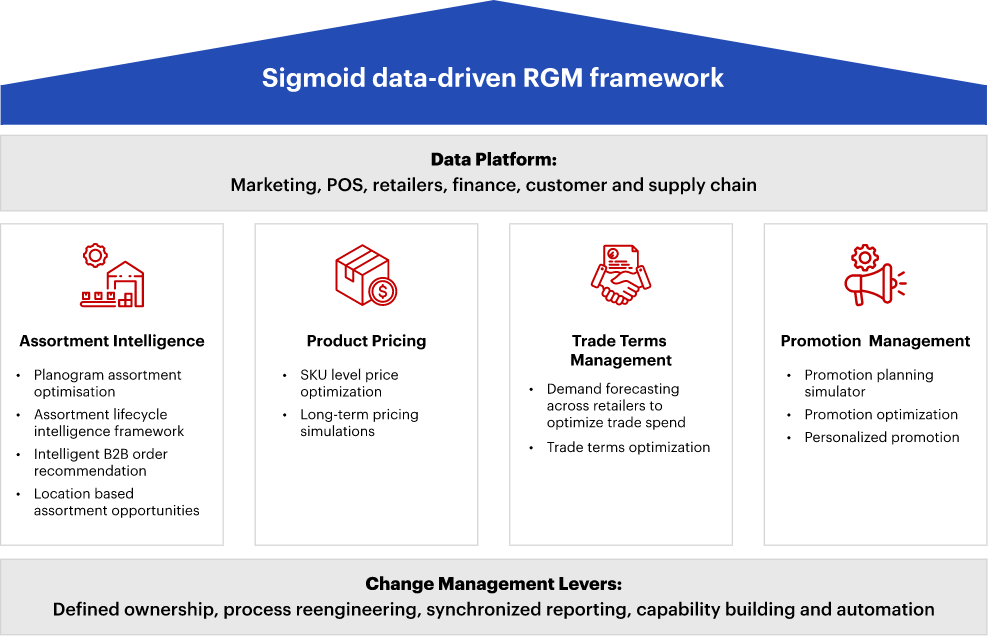Maximize profit with data-driven revenue growth management
- Chapter- 1What is revenue growth management?
- Chapter- 2RGM for modern-day CPGs
- Chapter- 3Data-driven revenue growth framework
- Chapter- 4Components of an effective RGM strategy
- Chapter- 5KPIs to measure RGM success
- Chapter- 6Best practices to execute RGM strategies
- Chapter- 7Impact delivered by effective RGM strategy
- Chapter- 8Trends
- Chapter- 9RGM Success Stories
- Chapter- 10FAQs
What is revenue growth management?
Revenue growth management (RGM)—also known as net revenue management—isn’t just another pricing program. Rather, it’s an integrated approach to handle net revenue, which is essential for funding operations and production. Revenue growth management can be defined as the increase in revenue due to the availability of the right brand/pack/brand-pack mix to the right consumer at the right price on the right occasion.
RGM, as a multi-disciplinary practice, involves analysis to planning into execution, spanning across multiple teams, processes, and areas of ownership within CPGs companies. That brings a need for alignment, both from a system perspective and also from an organizational and change management perspective.
Strategic revenue growth management approach for succeeding in the modern-day consumer goods landscape
CPG companies are facing immense pressure on their growth and profitability due to various factors – consumers buying lower-priced private-label products, competition from startups with new brands gaining market share from incumbents and the need to run extensive promotions in a competitive market eroding profit margins.
To address these challenges, net revenue management is a strategic imperative. An effective RGM implementation helps CPGs stay ahead of the curve to realize many benefits:
- Understanding consumers: RGM leverages advanced analytics to gain deep insights into evolving consumer behaviors and preferences. This understanding enables you to cater to consumer needs more effectively.
- Maximizing profit margins: Through pricing optimization, promotional effectiveness, and trade spend optimization, RGM aims to ensure that every dollar spent yields the maximum ROI, even in inflationary market conditions.
- Achieving competitive advantage: An effective RGM strategy allows businesses to differentiate themselves in the market. By understanding consumer purchase behavior and market trends, you can make strategic decisions that set you apart from competitors.
- Supporting innovation: The insights derived from RGM can fuel innovation. By understanding what consumers value, you can develop new products and services that meet unfulfilled needs or create new market segments rather than just cannibalizing your existing business.
- Optimizing product assortment: RGM helps companies determine the optimal product mix for various customer segments, channels, and regions. This ensures that you are offering the right products to the target consumers and ensures steady growth even in mature categories or markets.
- Managing market volatility: By continually analyzing sales data, market trends, and consumer behavior, you can make proactive decisions that keep you prepared for any market disruptions, roadblocks or changes in the regulatory environment.
With a customized RGM strategy in place, CPG companies can achieve their true potential across their various product categories, brands, sales channels, and markets, thereby enhancing their decision-making capabilities and increasing their revenue and profit margins.
Data-driven revenue growth framework
Many consumer packaged goods CPG companies are turning to revenue growth management to boost their top and bottom lines. They’re also striving to build the capabilities essential for strengthening net revenue on their own. Sigmoid’s approach to revenue growth and data-driven RGM framework helps to bring all the different components together at an enterprise scale, and accelerates your revenue management journey.

Key components of an effective revenue growth management strategy
The key levers driving revenue and profitability growth for CPG companies are pricing, promotion, product mix, trade investment and price pack architecture. Whether you're new to the concept of RGM or looking to refine your existing strategies, understanding these key areas is pivotal. These building blocks of RGM are vital in order to maximize your revenue and profitability.
- Pricing models and price-pack architecture: Maximize ROI from dynamic pricing decisions by quantifying SKU/PPG level impacts to drive profitable outcomes.The strategy concerns how a product is priced in the market and focuses on setting the right market price. Calculate price elasticities, identify price thresholds and optimize price pack architecture to deliver a defensible pricing structure across brands, channels and markets.
- Product assortment optimization and portfolio management: This involves curating the ideal assortment of products across various channels, locations and consumer preferences while also balancing the internal product portfolio for maximum sales and minimal stock-keeping unit (SKU) complexity. Identify underperforming products, portfolio gaps and white spaces.
- Trade terms management: Optimize payment terms, promotional planning and discounts based on demand forecasts across channels. This also involves fine-tuning trade funds allocation and overall investment, fact-based negotiation with retail customers, contracts, and pricing models to sustain brand equity and retailer relationships. Maximize sales and long term profit returns while meeting retailer needs.
- Promotion campaign and effectiveness analytics: Focus on promotional strategies that fuel consumer demand, relying on insights from omnichannel consumer behavior analysis. Devise proactive and hyper-personalized campaigns to achieve maximum ROI by allocating optimal marketing spend for each media lever.

Data-driven revenue growth management solutions for CPGs
Traditionally, core RGM strategies have been tactical and reactional. However, in the present-day market landscape, several factors need to be considered to create an effective RGM solution that enables the overall CPG commercial strategy.
KPIs to measure RGM success
In order to measure business performance and success of your RGM strategy, here are a few KPIs (not exhaustive) that can be monitored:
| KPI | What it measures |
|---|---|
| Revenue growth | The percentage increase in your company's revenue over a specific period, measured on a quarterly or annual (year-over-year) basis. |
| Profit margin | Company's profitability for each dollar of sales, expressed as a percentage |
| Market share | The percentage of total sales in your industry that your company holds |
| Price elasticity | How sensitive your customers are to changes in price |
| Promotion effectiveness– Lift | The increase generated from promotional activity, expressed as a percentage |
| Promotional effectiveness– Incremental sales | The increase generated from promotional activity, expressed in dollars, units, volume, or profit |
| Net sales | The total revenues minus allowances, discounts, and returns |
| Trade rate | Trade spend as a percentage of gross sales can be calculated for a specific time period (fiscal year) or on an event basis |
| Margin/contribution margin | How much of a product’s sales revenue remains after deducting the variable costs associated with selling it |
| Trade ROI or Promo-spend ROI | The gain from trade promotion activities (including discounts, rebates, and retailer incentives) divided by the cost of the promotions, expressed as a percentage |
Best practices to execute RGM strategies effectively
Delivering significant, sustainable revenue growth is never easy. But with expectations rising, markets becoming increasingly crowded, and transformational forces moving faster than ever before, making the right decisions at the right time has become a necessity.
- Connect disparate data sources to anticipate risks and identify real opportunities – both in the market, and in their channels
- Understand rapidly shifting shopper behaviors and keep pace with changing demands to safeguard loyalty and maintain market share
- Improve planning and retailer collaboration by using their insights to offer recommendations that help retailers identify favorable sales opportunities
- Monitor spend effectiveness and respond to emerging trends quickly to maximize incremental gains through analytics-driven scenario assessment
- Develop a holistic view of market and organizational metrics to track and drive revenue growth opportunities
- Invest in flexible technology that can provide a single source of truth across multiple functions and areas to achieve effective plans, growth KPIs, and digital-era success.
- Become cross functional and collaborative to foster RGM capability building so that the whole organization becomes aligned on the effort.
How to build a data analytics team to maximize revenue growth for digital business
Capitalizing on data for business growth is dependent on building the right team which must interface between business and IT.
Impact delivered by effective RGM strategy
Data-driven RGM can deliver high business value and benefits across all the key pillars:
Trends
Trends in Revenue Growth Management
Modern RGM requires a combination of fundamental levels including Strategic RGM for longer-term value creation and category growth, and Precision RGM which uses new analysis and data sources to develop highly tailored price, promotion, and assortment strategies.
RGM is moving steadily towards the core of how CPG organizations operate, particularly as more companies credit it with mitigating the impact of inflation and helping to fuel profitability and growth.
It is crucial to keep an eye on the latest industry trends and forces that can impact your revenue growth strategy. By understanding and harnessing these trends, you can position yourself for continued success:
- Higher investment in advanced data and analytics for insights: Advanced modeling and artificial intelligence will automatically generate plans and scenarios with the highest statistical likelihood of success in the market, taking into account shopper behaviors, macro- and microeconomic factors, top-line revenue and profit targets, and supply constraints. These insights will give you the ability to optimize product assortments, pricing, promotion, and planograms at channel, account, and even store/store-cluster levels.
- CPGs focus delivering customer-centric value: Consumers will also expect personalized, engaging, and meaningful interactions with brands, seeking value in the overall experience rather than just the product itself. Revenue growth managers need to focus on delivering exceptional customer experiences, leveraging technology and data to tailor offerings, and creating a sense of value and loyalty.
- Generative AI is democratizing recommendations: Generative AI solutions can produce insights and recommend actions to take sales planning from months to minutes with a greater likelihood of delivering favorable results. Gen AI also provides more context to scenario planning, providing explanations for its suggestions so you can understand the rationale behind its recommendations.
- Rise of omni-channel RGM: As consumers purchase more outside of brick and mortar, the need for analysis to understand the interplay between promotions, profitability, demand, and cannibalization has increased. Companies need to use and integrate their sell-out/consumption sales data for the success of e-commerce and omni-channel revenue growth.
At its core, revenue growth management is about consumer-centric segmentation, ensuring that the right products in the right package, in the right channel, at the right price point, driving transactions, and meeting consumers where they are.
Revenue Growth Management Client Success Stories
FAQs
Revenue Growth Management (RGM) is a strategic framework that enables companies to optimize pricing, promotions, product mix, and customer segmentation to drive sustainable and profitable growth.
RGM is essential for CPG companies to navigate market volatility, inflation, and evolving consumer behaviors by leveraging data and analytics to make informed, revenue-focused decisions.
Sigmoid enables end-to-end RGM by unifying data from multiple sources, applying advanced analytics and AI models, and delivering actionable insights to optimize pricing, promotions, and assortment decisions.
RGM influences pricing strategies by analyzing market demand, competitive pricing, and customer behavior. It helps businesses set optimal prices to maximize revenue and respond effectively to market changes.
Common pitfalls in pursuing Revenue Growth Management (RGM) include insufficient data analysis, lack of cross-functional collaboration, and short-term focus. Periodic evaluations, continuous learning, and adaptability are key to navigating challenges and achieving successful RGM outcomes. Ensure clear communication of RGM goals across the organization, align strategies with market dynamics, and regularly reassess and adjust tactics. Prioritize customer-centric approaches, understanding their needs and preferences to drive sustainable revenue growth.
Revenue growth management roadmap assists in effectively managing product life cycles by analyzing sales data, adjusting pricing and promotions, and making strategic decisions to extend or phase out products at different stages of their life cycle.
Yes, RGM principles are applicable across various industries, including retail, consumer goods, healthcare, and technology. The specific strategies may vary, but the core concept of optimizing revenue remains consistent. Businesses of all sizes can benefit from RGM by tailoring strategies to their specific market and operational needs.
Integrating sustainability into RGM strategies not only aligns businesses with societal values but also meets the growing consumer demand for eco-friendly products. It can lead to enhanced brand reputation and customer loyalty.










